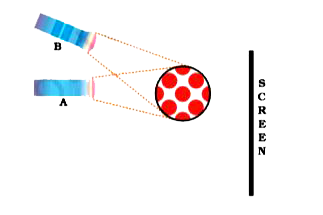A torch is placed at two different positions A and B, one by one, as shown in Fig. 11.9.

The shape of the shadow obtained in two positions is shown in Fig. 11.10

Match the position of the torch and shape of the shadow of the ball.
Step by step video & image solution for A torch is placed at two different positions A and B, one by one, as shown in Fig. 11.9. The shape of the shadow obtained in two positions is shown in Fig. 11.10 Match the position of the torch and shape of the shadow of the ball. by Physics experts to help you in doubts & scoring excellent marks in Class 6 exams.
Updated on:21/07/2023Topper's Solved these Questions
- LIGHTBOOK - NCERT EXEMPLARCHAPTER - LIGHTEXERCISE - LONG ANSWER QUESTIONS
3 Videos
- LIGHTBOOK - NCERT EXEMPLARCHAPTER - LIGHTEXERCISE - LONG ANSWER QUESTIONS
3 Videos
- FUN WITH MAGNETSBOOK - NCERT EXEMPLARCHAPTER - FUN WITH MAGNETSEXERCISE - LONG ANSWER QUESTIONS
7 Videos
- MOTION AND MEASUREMENT OF DISTANCES BOOK - NCERT EXEMPLARCHAPTER - MOTION AND MEASUREMENT OF DISTANCES EXERCISE - LONG ANSWER QUESTIONS
4 Videos
Similar Questions
Knowledge Check

The temperature across two different slabs A and B are shown I the steady state (as shown Fig) The ratio of thermal conductivities of A and B isA2:3B3:2C1:1D5:3Four different positions of the same dice are shown. Find the number on the face opposite to the one having 3.
 A6B4C2D1
A6B4C2D1A block is raised from position A to B by taking two different paths as shown in the figure. If AB = h, then
 Athe work done on the block is greater in case of path 1 than in case of path 2Bthe work done on the block is greater in case of path 2 than in case of path 1Cthe work done on the block is same for both pathsDthe work done cannot be determined.
Athe work done on the block is greater in case of path 1 than in case of path 2Bthe work done on the block is greater in case of path 2 than in case of path 1Cthe work done on the block is same for both pathsDthe work done cannot be determined.
Three different positions of the same dice are shown. Select the symbol that will be on the face opposite to the one showing ‘<’.

View SolutionThree different positions of the same dice are shown. Select the symbol that will be on the face opposite to the one showing ‘=’.

View SolutionThree different position of the same dice are shown. Select the symbol that will be on the face opposite to the one showing '@'

View SolutionThree different positions of the same dice are shown. Select the symbol that will be on the face opposite to the one showing ‘+’.

View SolutionThree different positions of the same dice are shown. Select the symbol that will be on the face opposite to the one showing ’%’.

View Solution


